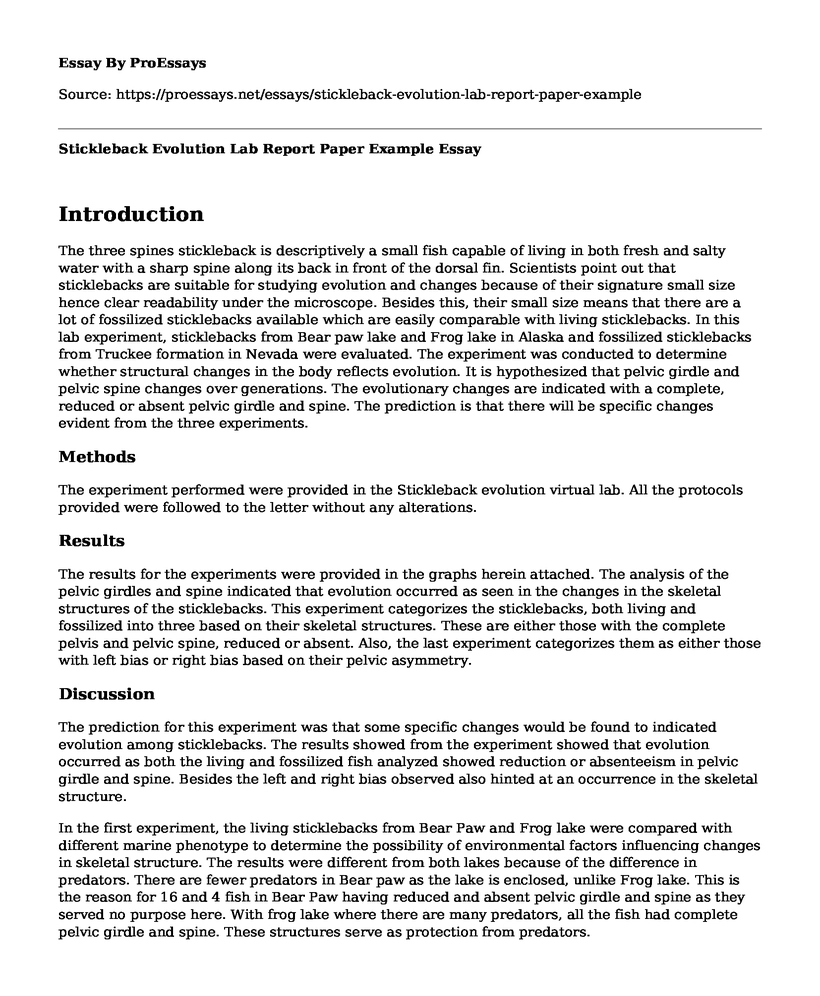Introduction
The three spines stickleback is descriptively a small fish capable of living in both fresh and salty water with a sharp spine along its back in front of the dorsal fin. Scientists point out that sticklebacks are suitable for studying evolution and changes because of their signature small size hence clear readability under the microscope. Besides this, their small size means that there are a lot of fossilized sticklebacks available which are easily comparable with living sticklebacks. In this lab experiment, sticklebacks from Bear paw lake and Frog lake in Alaska and fossilized sticklebacks from Truckee formation in Nevada were evaluated. The experiment was conducted to determine whether structural changes in the body reflects evolution. It is hypothesized that pelvic girdle and pelvic spine changes over generations. The evolutionary changes are indicated with a complete, reduced or absent pelvic girdle and spine. The prediction is that there will be specific changes evident from the three experiments.
Methods
The experiment performed were provided in the Stickleback evolution virtual lab. All the protocols provided were followed to the letter without any alterations.
Results
The results for the experiments were provided in the graphs herein attached. The analysis of the pelvic girdles and spine indicated that evolution occurred as seen in the changes in the skeletal structures of the sticklebacks. This experiment categorizes the sticklebacks, both living and fossilized into three based on their skeletal structures. These are either those with the complete pelvis and pelvic spine, reduced or absent. Also, the last experiment categorizes them as either those with left bias or right bias based on their pelvic asymmetry.
Discussion
The prediction for this experiment was that some specific changes would be found to indicated evolution among sticklebacks. The results showed from the experiment showed that evolution occurred as both the living and fossilized fish analyzed showed reduction or absenteeism in pelvic girdle and spine. Besides the left and right bias observed also hinted at an occurrence in the skeletal structure.
In the first experiment, the living sticklebacks from Bear Paw and Frog lake were compared with different marine phenotype to determine the possibility of environmental factors influencing changes in skeletal structure. The results were different from both lakes because of the difference in predators. There are fewer predators in Bear paw as the lake is enclosed, unlike Frog lake. This is the reason for 16 and 4 fish in Bear Paw having reduced and absent pelvic girdle and spine as they served no purpose here. With frog lake where there are many predators, all the fish had complete pelvic girdle and spine. These structures serve as protection from predators.
In the second experiment with fossilized sticklebacks, the number of complete pelvises changed over the years with a decrease in frequency of fossilized sticklebacks with complete pelvic girdle and spine. This is another evidence for change occurring over the years. The results can help determine the rate of change over time.
Ultimately, the third experiment showed that the pelvic girdle and spine reduced with the vestiges more significant on the left in the majority of the fish than on the right. As observed, the left bias among the fish from Bear Paw and Coyote lakes suggests that mutation is associated with the reduction in the pelvic affecting the function of gene Pitx1.
Conclusion
In summary, the specific changes discovered from the three experiments altogether prove the occurrence of evolution. Most of the stickleback scored in the experiments showed a change in their pelvic skeletal structures. This is a response to adaptation and changing to suit their specific environments. This is affirmed from both living and fossilized sticklebacks.
Cite this page
Stickleback Evolution Lab Report Paper Example. (2022, Oct 20). Retrieved from https://proessays.net/essays/stickleback-evolution-lab-report-paper-example
If you are the original author of this essay and no longer wish to have it published on the ProEssays website, please click below to request its removal:
- Defining Structured Diabetes Education
- Senegal Market Research: International Business
- Research Paper on Effect of Sleep Habits on Physical Activity
- Essay Example on Adapting to Changes: The Hedonic Thread Mill
- My Leadership Strengths and Areas for Growth: A Reflective Essay
- Nurses: The Patient's Greatest Advocates in Healthcare Delivery - Research Paper
- Essay Sample on Sustaining Patient-Centered Medical Homes: Strategies, Innovations, and Policy Impacts







